ECO mode Seat Altea XL 2014 Owner's Guide
[x] Cancel search | Manufacturer: SEAT, Model Year: 2014, Model line: Altea XL, Model: Seat Altea XL 2014Pages: 321, PDF Size: 4.52 MB
Page 212 of 321
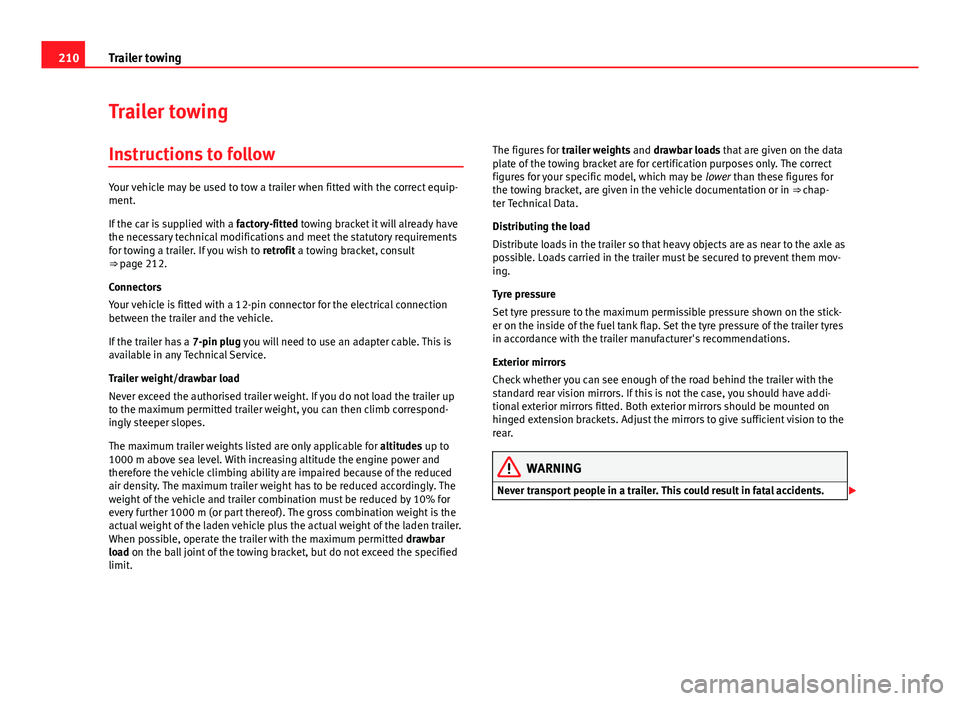
210Trailer towing
Trailer towing
Instructions to follow
Your vehicle may be used to tow a trailer when fitted with the correct equip-
ment.
If the car is supplied with a factory-fitted towing bracket it will already have
the necessary technical modifications and meet the statutory requirements
for towing a trailer. If you wish to retrofit a towing bracket, consult
⇒ page 212.
Connectors
Your vehicle is fitted with a 12-pin connector for the electrical connection
between the trailer and the vehicle.
If the trailer has a 7-pin plug you will need to use an adapter cable. This is
available in any Technical Service.
Trailer weight/drawbar load
Never exceed the authorised trailer weight. If you do not load the trailer up
to the maximum permitted trailer weight, you can then climb correspond-
ingly steeper slopes.
The maximum trailer weights listed are only applicable for altitudes up to
1000 m above sea level. With increasing altitude the engine power and
therefore the vehicle climbing ability are impaired because of the reduced
air density. The maximum trailer weight has to be reduced accordingly. The
weight of the vehicle and trailer combination must be reduced by 10% for
every further 1000 m (or part thereof). The gross combination weight is the
actual weight of the laden vehicle plus the actual weight of the laden trailer.
When possible, operate the trailer with the maximum permitted drawbar
load on the ball joint of the towing bracket, but do not exceed the specified
limit. The figures for
trailer weights and drawbar loads that are given on the data
plate of the towing bracket are for certification purposes only. The correct
figures for your specific model, which may be lower than these figures for
the towing bracket, are given in the vehicle documentation or in ⇒ chap-
ter Technical Data.
Distributing the load
Distribute loads in the trailer so that heavy objects are as near to the axle as
possible. Loads carried in the trailer must be secured to prevent them mov-
ing.
Tyre pressure
Set tyre pressure to the maximum permissible pressure shown on the stick-
er on the inside of the fuel tank flap. Set the tyre pressure of the trailer tyres
in accordance with the trailer manufacturer's recommendations.
Exterior mirrors
Check whether you can see enough of the road behind the trailer with the
standard rear vision mirrors. If this is not the case, you should have addi-
tional exterior mirrors fitted. Both exterior mirrors should be mounted on
hinged extension brackets. Adjust the mirrors to give sufficient vision to the
rear.
WARNING
Never transport people in a trailer. This could result in fatal accidents.
Page 213 of 321
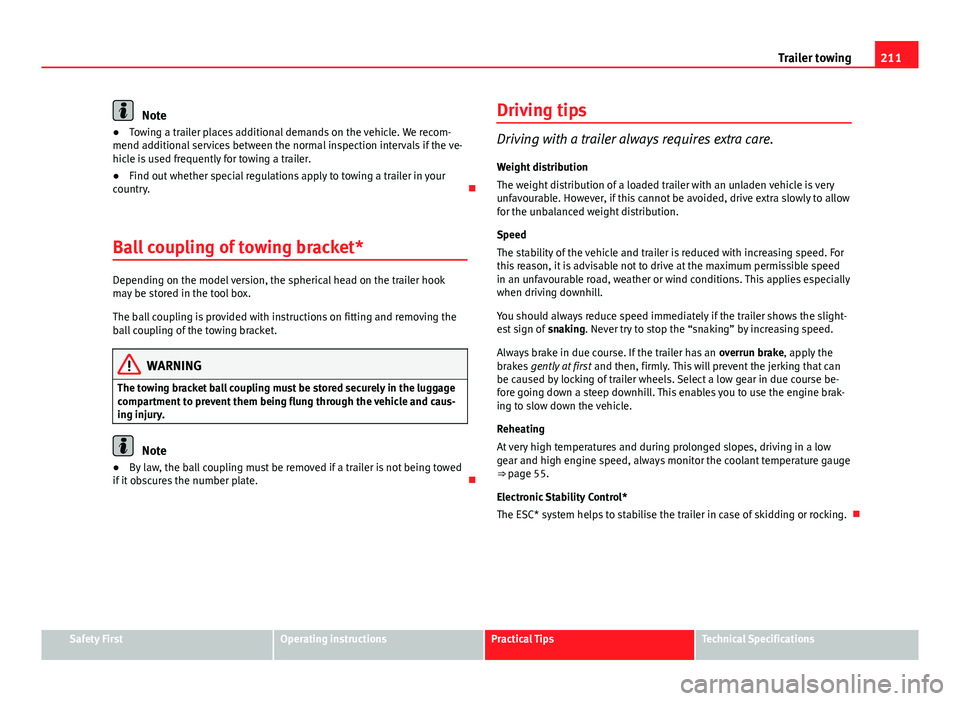
211
Trailer towing
Note
● Towing a trailer places additional demands on the vehicle. We recom-
mend additional services between the normal inspection intervals if the ve-
hicle is used frequently for towing a trailer.
● Find out whether special regulations apply to towing a trailer in your
country.
Ball coupling of towing bracket*
Depending on the model version, the spherical head on the trailer hook
may be stored in the tool box.
The ball coupling is provided with instructions on fitting and removing the
ball coupling of the towing bracket.
WARNING
The towing bracket ball coupling must be stored securely in the luggage
compartment to prevent them being flung through the vehicle and caus-
ing injury.
Note
● By law, the ball coupling must be removed if a trailer is not being towed
if it obscures the number plate. Driving tips
Driving with a trailer always requires extra care.
Weight distribution
The weight distribution of a loaded trailer with an unladen vehicle is very
unfavourable. However, if this cannot be avoided, drive extra slowly to allow
for the unbalanced weight distribution.
Speed
The stability of the vehicle and trailer is reduced with increasing speed. For
this reason, it is advisable not to drive at the maximum permissible speed
in an unfavourable road, weather or wind conditions. This applies especially
when driving downhill.
You should always reduce speed immediately if the trailer shows the slight-
est sign of snaking. Never try to stop the “snaking” by increasing speed.
Always brake in due course. If the trailer has an overrun brake, apply the
brakes gently at first and then, firmly. This will prevent the jerking that can
be caused by locking of trailer wheels. Select a low gear in due course be-
fore going down a steep downhill. This enables you to use the engine brak-
ing to slow down the vehicle.
Reheating
At very high temperatures and during prolonged slopes, driving in a low
gear and high engine speed, always monitor the coolant temperature gauge
⇒ page 55.
Electronic Stability Control*
The ESC* system helps to stabilise the trailer in case of skidding or rocking.
Safety FirstOperating instructionsPractical TipsTechnical Specifications
Page 215 of 321
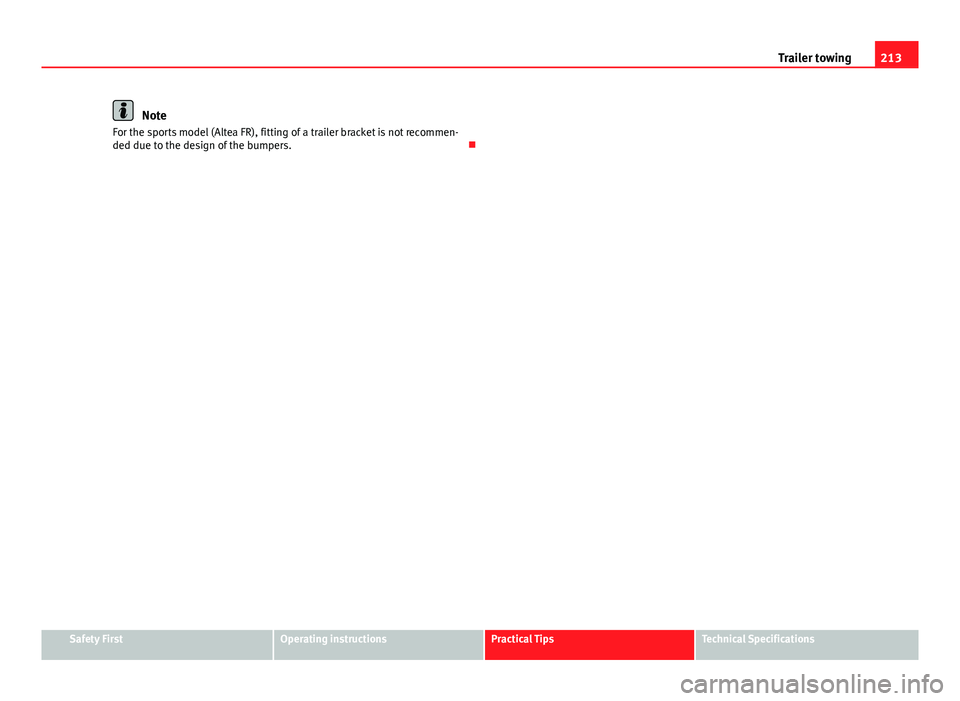
213
Trailer towing
Note
For the sports model (Altea FR), fitting of a trailer bracket is not recommen-
ded due to the design of the bumpers.
Safety FirstOperating instructionsPractical TipsTechnical Specifications
Page 261 of 321
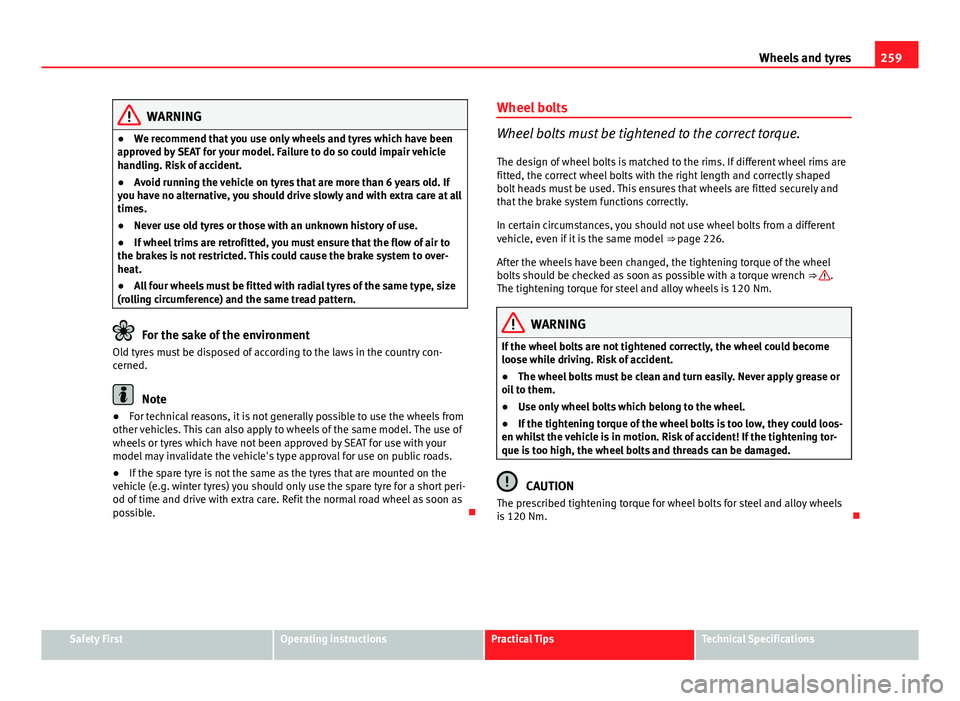
259
Wheels and tyres
WARNING
● We recommend that you use only wheels and tyres which have been
approved by SEAT for your model. Failure to do so could impair vehicle
handling. Risk of accident.
● Avoid running the vehicle on tyres that are more than 6 years old. If
you have no alternative, you should drive slowly and with extra care at all
times.
● Never use old tyres or those with an unknown history of use.
● If wheel trims are retrofitted, you must ensure that the flow of air to
the brakes is not restricted. This could cause the brake system to over-
heat.
● All four wheels must be fitted with radial tyres of the same type, size
(rolling circumference) and the same tread pattern.
For the sake of the environment
Old tyres must be disposed of according to the laws in the country con-
cerned.
Note
● For technical reasons, it is not generally possible to use the wheels from
other vehicles. This can also apply to wheels of the same model. The use of
wheels or tyres which have not been approved by SEAT for use with your
model may invalidate the vehicle's type approval for use on public roads.
● If the spare tyre is not the same as the tyres that are mounted on the
vehicle (e.g. winter tyres) you should only use the spare tyre for a short peri-
od of time and drive with extra care. Refit the normal road wheel as soon as
possible. Wheel bolts
Wheel bolts must be tightened to the correct torque.
The design of wheel bolts is matched to the rims. If different wheel rims are
fitted, the correct wheel bolts with the right length and correctly shaped
bolt heads must be used. This ensures that wheels are fitted securely and
that the brake system functions correctly.
In certain circumstances, you should not use wheel bolts from a different
vehicle, even if it is the same model ⇒ page 226.
After the wheels have been changed, the tightening torque of the wheel
bolts should be checked as soon as possible with a torque wrench ⇒
.
The tightening torque for steel and alloy wheels is 120 Nm.
WARNING
If the wheel bolts are not tightened correctly, the wheel could become
loose while driving. Risk of accident.
● The wheel bolts must be clean and turn easily. Never apply grease or
oil to them.
● Use only wheel bolts which belong to the wheel.
● If the tightening torque of the wheel bolts is too low, they could loos-
en whilst the vehicle is in motion. Risk of accident! If the tightening tor-
que is too high, the wheel bolts and threads can be damaged.
CAUTION
The prescribed tightening torque for wheel bolts for steel and alloy wheels
is 120 Nm.
Safety FirstOperating instructionsPractical TipsTechnical Specifications
Page 297 of 321
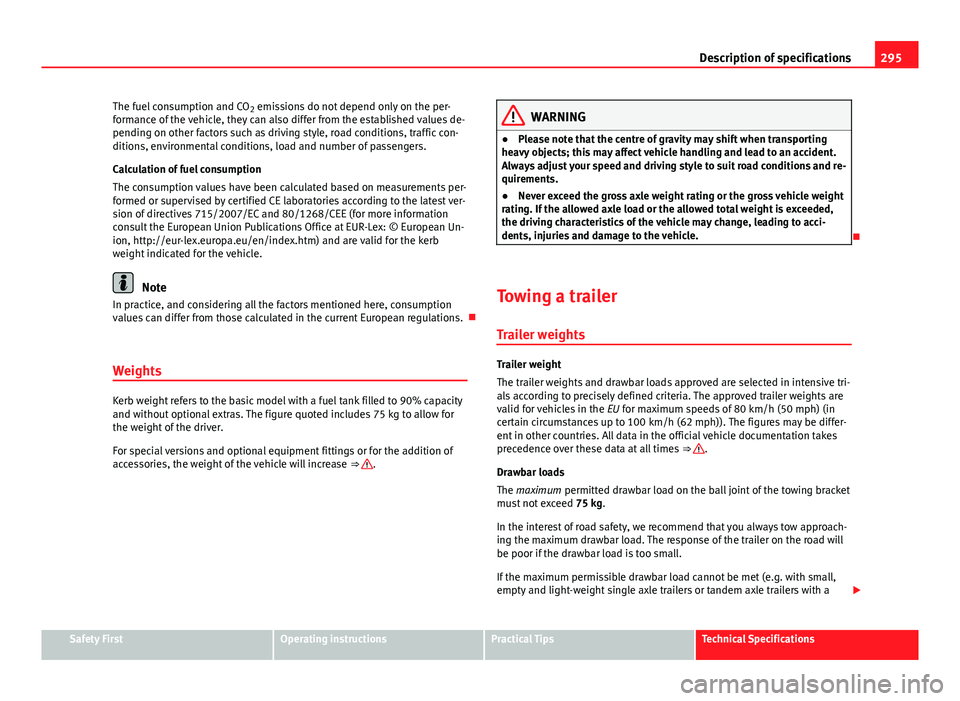
295
Description of specifications
The fuel consumption and CO 2 emissions do not depend only on the per-
formance of the vehicle, they can also differ from the established values de-
pending on other factors such as driving style, road conditions, traffic con-
ditions, environmental conditions, load and number of passengers.
Calculation of fuel consumption
The consumption values have been calculated based on measurements per-
formed or supervised by certified CE laboratories according to the latest ver-
sion of directives 715/2007/EC and 80/1268/CEE (for more information
consult the European Union Publications Office at EUR-Lex: © European Un-
ion, http://eur-lex.europa.eu/en/index.htm) and are valid for the kerb
weight indicated for the vehicle.
Note
In practice, and considering all the factors mentioned here, consumption
values can differ from those calculated in the current European regulations.
Weights
Kerb weight refers to the basic model with a fuel tank filled to 90% capacity
and without optional extras. The figure quoted includes 75 kg to allow for
the weight of the driver.
For special versions and optional equipment fittings or for the addition of
accessories, the weight of the vehicle will increase ⇒
.
WARNING
● Please note that the centre of gravity may shift when transporting
heavy objects; this may affect vehicle handling and lead to an accident.
Always adjust your speed and driving style to suit road conditions and re-
quirements.
● Never exceed the gross axle weight rating or the gross vehicle weight
rating. If the allowed axle load or the allowed total weight is exceeded,
the driving characteristics of the vehicle may change, leading to acci-
dents, injuries and damage to the vehicle.
Towing a trailer Trailer weights
Trailer weight
The trailer weights and drawbar loads approved are selected in intensive tri-
als according to precisely defined criteria. The approved trailer weights are
valid for vehicles in the EU for maximum speeds of 80 km/h (50 mph) (in
certain circumstances up to 100 km/h (62 mph)). The figures may be differ-
ent in other countries. All data in the official vehicle documentation takes
precedence over these data at all times ⇒
.
Drawbar loads
The maximum permitted drawbar load on the ball joint of the towing bracket
must not exceed 75 kg.
In the interest of road safety, we recommend that you always tow approach-
ing the maximum drawbar load. The response of the trailer on the road will
be poor if the drawbar load is too small.
If the maximum permissible drawbar load cannot be met (e.g. with small,
empty and light-weight single axle trailers or tandem axle trailers with a
Safety FirstOperating instructionsPractical TipsTechnical Specifications
Page 316 of 321
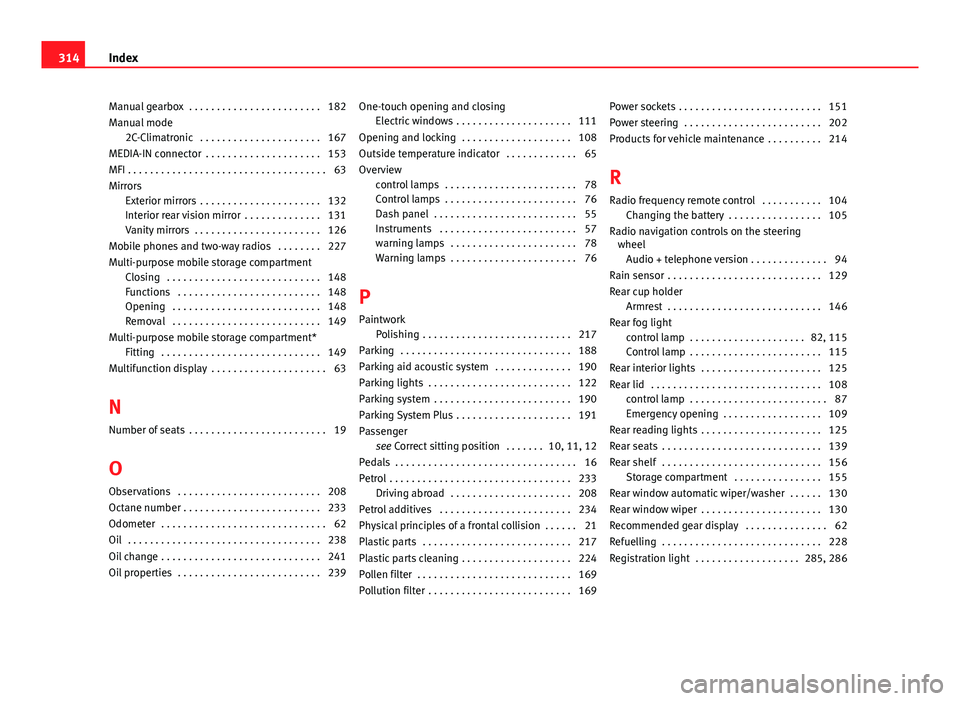
Manual gearbox . . . . . . . . . . . . . . . . . . . . . . . . 182
Manual mode2C-Climatronic . . . . . . . . . . . . . . . . . . . . . . 167
MEDIA-IN connector . . . . . . . . . . . . . . . . . . . . . 153
MFI . . . . . . . . . . . . . . . . . . . . . . . . . . . . . . . . . . . . 63
Mirrors Exterior mirrors . . . . . . . . . . . . . . . . . . . . . . 132
Interior rear vision mirror . . . . . . . . . . . . . . 131
Vanity mirrors . . . . . . . . . . . . . . . . . . . . . . . 126
Mobile phones and two-way radios . . . . . . . . 227
Multi-purpose mobile storage compartment Closing . . . . . . . . . . . . . . . . . . . . . . . . . . . . 148
Functions . . . . . . . . . . . . . . . . . . . . . . . . . . 148
Opening . . . . . . . . . . . . . . . . . . . . . . . . . . . 148
Removal . . . . . . . . . . . . . . . . . . . . . . . . . . . 149
Multi-purpose mobile storage compartment* Fitting . . . . . . . . . . . . . . . . . . . . . . . . . . . . . 149
Multifunction display . . . . . . . . . . . . . . . . . . . . . 63
N
Number of seats . . . . . . . . . . . . . . . . . . . . . . . . . 19
O
Observations . . . . . . . . . . . . . . . . . . . . . . . . . . 208
Octane number . . . . . . . . . . . . . . . . . . . . . . . . . 233
Odometer . . . . . . . . . . . . . . . . . . . . . . . . . . . . . . 62
Oil . . . . . . . . . . . . . . . . . . . . . . . . . . . . . . . . . . . 238
Oil change . . . . . . . . . . . . . . . . . . . . . . . . . . . . . 241
Oil properties . . . . . . . . . . . . . . . . . . . . . . . . . . 239 One-touch opening and closing
Electric windows . . . . . . . . . . . . . . . . . . . . . 111
Opening and locking . . . . . . . . . . . . . . . . . . . . 108
Outside temperature indicator . . . . . . . . . . . . . 65
Overview control lamps . . . . . . . . . . . . . . . . . . . . . . . . 78
Control lamps . . . . . . . . . . . . . . . . . . . . . . . . 76
Dash panel . . . . . . . . . . . . . . . . . . . . . . . . . . 55
Instruments . . . . . . . . . . . . . . . . . . . . . . . . . 57
warning lamps . . . . . . . . . . . . . . . . . . . . . . . 78
Warning lamps . . . . . . . . . . . . . . . . . . . . . . . 76
P Paintwork Polishing . . . . . . . . . . . . . . . . . . . . . . . . . . . 217
Parking . . . . . . . . . . . . . . . . . . . . . . . . . . . . . . . 188
Parking aid acoustic system . . . . . . . . . . . . . . 190
Parking lights . . . . . . . . . . . . . . . . . . . . . . . . . . 122
Parking system . . . . . . . . . . . . . . . . . . . . . . . . . 190
Parking System Plus . . . . . . . . . . . . . . . . . . . . . 191
Passenger see Correct sitting position . . . . . . . 10, 11, 12
Pedals . . . . . . . . . . . . . . . . . . . . . . . . . . . . . . . . . 16
Petrol . . . . . . . . . . . . . . . . . . . . . . . . . . . . . . . . . 233 Driving abroad . . . . . . . . . . . . . . . . . . . . . . 208
Petrol additives . . . . . . . . . . . . . . . . . . . . . . . . 234
Physical principles of a frontal collision . . . . . . 21
Plastic parts . . . . . . . . . . . . . . . . . . . . . . . . . . . 217
Plastic parts cleaning . . . . . . . . . . . . . . . . . . . . 224
Pollen filter . . . . . . . . . . . . . . . . . . . . . . . . . . . . 169
Pollution filter . . . . . . . . . . . . . . . . . . . . . . . . . . 169 Power sockets . . . . . . . . . . . . . . . . . . . . . . . . . . 151
Power steering . . . . . . . . . . . . . . . . . . . . . . . . . 202
Products for vehicle maintenance . . . . . . . . . . 214
R Radio frequency remote control . . . . . . . . . . . 104 Changing the battery . . . . . . . . . . . . . . . . . 105
Radio navigation controls on the steering wheel
Audio + telephone version . . . . . . . . . . . . . . 94
Rain sensor . . . . . . . . . . . . . . . . . . . . . . . . . . . . 129
Rear cup holder Armrest . . . . . . . . . . . . . . . . . . . . . . . . . . . . 146
Rear fog light control lamp . . . . . . . . . . . . . . . . . . . . . 82, 115
Control lamp . . . . . . . . . . . . . . . . . . . . . . . . 115
Rear interior lights . . . . . . . . . . . . . . . . . . . . . . 125
Rear lid . . . . . . . . . . . . . . . . . . . . . . . . . . . . . . . 108 control lamp . . . . . . . . . . . . . . . . . . . . . . . . . 87
Emergency opening . . . . . . . . . . . . . . . . . . 109
Rear reading lights . . . . . . . . . . . . . . . . . . . . . . 125
Rear seats . . . . . . . . . . . . . . . . . . . . . . . . . . . . . 139
Rear shelf . . . . . . . . . . . . . . . . . . . . . . . . . . . . . 156 Storage compartment . . . . . . . . . . . . . . . . 155
Rear window automatic wiper/washer . . . . . . 130
Rear window wiper . . . . . . . . . . . . . . . . . . . . . . 130
Recommended gear display . . . . . . . . . . . . . . . 62
Refuelling . . . . . . . . . . . . . . . . . . . . . . . . . . . . . 228
Registration light . . . . . . . . . . . . . . . . . . . 285, 286
314 Index